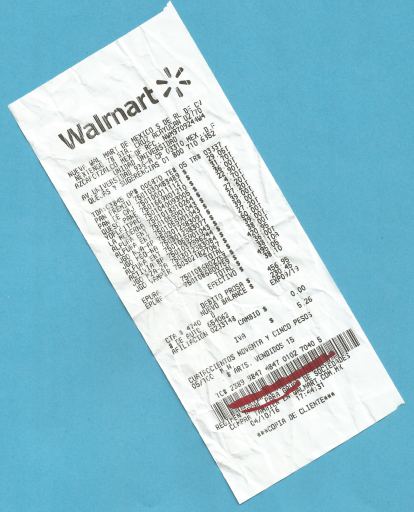| Classification Algorithm | Support Vector Classifier |
| Language | Python 3.5 |
| Libraries | OpenCV, Tesseract, scikit-learn |
| Source Code | Receipt Classifier |
This application recognizes whether a receipt belongs to a specific store (Walmart). It pre-processes image using OpenCV python library cv2, extracts the text from processed image using Tesseract and then uses supervised SVC (Support Vector Classifier) model to classify test receipts.
Usage
The source code of the application can be accessed here.
- Configuration: Paths of input image, pre-processed image, extracted text files, traning and test csvs are configured in config.yml
- Execution: Execute main.py to run the application.
Image Pre-Processesing
Image pre-processing is being done to improve receipt image quality before extracting text using tesseract. In this process, blocks of texts are identified and cropped to generated processed image. The approach includes following steps.
- Rescaling: Input images give are of larges sizes. They are rescaled to smaller dimension in order to speed up image pre-processing.
- Binarization: Images are converted to Grayscale and then binarized using adaptive Threshold.
- Denoising and Morphological Transformation: Morphological Opening is done to remove noises and then Closing is done in order to close small holes in texts in the binary image.
- Finding Countours of Text Blocks: Morphological Gradient followed by Closing is performed to find contours of text blocks.
- Generating Mask from Text Block Contours: Mask from contours of text blocks is generated, which is used for cropping required text blocks.
- Cropping text blocks from binary image using mask: The output is being saved as processed image which is to be parsed by tesseract.
Extracting Text from Pre-Processesed Images
pytesseract, Python wrapper over Tesseract OCR utility is being used to extract text from images using following command.
extracted_str = image_to_string(Image.open(ImgProcPath), lang="eng", config="-psm 1")
Building Classification Model
Support Vector Classfiers work well for text classification because of high-dimensional nature of text documents and robust performance of SVMs in high-feature space. Linear kernel has been used here to speed up training the model and simply requirement of model tuning parameters.
text_clf = Pipeline([('vect', CountVectorizer()),
('tfidf', TfidfTransformer()),
('clf', SVC(kernel='linear',probability=True)),])
CountVectorizer: To convert text file in pipeline into a matrix of token counts.
TfidfTransformer: To scale down the impact of tokens that occur very frequently in a given corpus.
probability=True: To enable estimating class probabilities, which is being used to evaluate Prediction Score in test results.
Evaluating Classification Model
Cross-validation set is generated from a random sample of training data to evaluate the model. The cross-validation accuracy is measured using.
from sklearn.metrics import classification_report as clsr
print(clsr(y_cv, predicted, target_names=[str(i) for i in labels.classes_]))
Scope of Future Enhancements
- Combined image(Logo detection) + Text classification.
- Fuzzy lookup and replacement of incorrect closest words. (e.g. ‘almart’ with ‘walmart’ and ‘sav m ney’ with ‘save money’).
